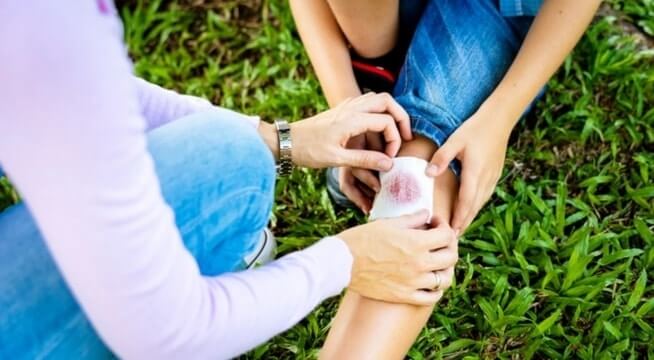How to Treat Cuts and Scrapes
Cuts & Wounds
•
Oct 5, 2018

Life is full of small hazards that lead to cuts and scrapes, like slicing an avocado or falling off a bike.
The next time you or a loved one gets banged up, follow these first aid tips.
Common Causes of Cuts and Scrapes
Cuts and scrapes occur when your skin breaks. This is typically the result of:
- Falling
- Hitting a hard object
- Being cut by something sharp
While cuts and scrapes are common enough, some people are more prone to these types of injuries. Children are usually sporting some type of minor skin damage due to clumsiness and rough play. Older people are more likely to get cuts and scrapes because of limited mobility, issues with balance and the delicacy of their skin from aging, illness or medications.
Complications of Cuts and Scrapes
Keeping your cut or scrape clean will allow it to heal properly and lower the chance of infection. Some signs of infection are:
- Redness, swelling or warmth around the affected area
- Fever
- Increased pain
- Discharge or pus
- Foul odor
If any of these signs appear, seek medical attention.
How to Treat Cuts
The first thing you want to do after getting cut is to clean the wound and stop the bleeding.
Cuts That Do Not Require Medical Attention
Step 1. Clean the cut with water and a mild soap to remove debris and bacteria. Avoid cotton or wool when cleaning, as fibers may get caught in the wound and cause infection.
Step 2. Use astringents, antiseptics or alcohol on the area surrounding the cut to kill bacteria.
Step 3. Dress the wound with a topical antibiotic to prevent infection.
Step 4. Cover the wound with either a Band-Aid or cloth wrap depending on the size.
Cuts That Require Medical Attention
If the cut meets any of the following criteria, seek medical attention.
- Bleeding lasts longer than 10 minutes
- The sides gape open if you let go of the cut
- It is deep – tissues like tendons, nerves or blood vessels may be damaged
- There is exposed muscle tissue (red) or fat tissue (yellowish)
- It appears dirty after being cleaned
- It is on a joint or somewhere where healing might be difficult
Stitches or Glue?
Stitches thread the wound together so the edges of the cut can be lined up squarely. This is particularly important if the cut is on a joint or somewhere that experiences a lot of movement. If the wound is jagged or uneven, stitches are also preferred.
Steri-Strips are fine, thin and sticky strips that act like stitches. They are used when the cut is deep, but not deep enough for stitches. If the cut is on the face, doctors might want to minimize scarring, so they’ll use Steri-Strips or butterfly strips to act as stitches.
Skin superglue is a substance that glues the skin together to heal. This is used when stitches can be avoided and in areas of minimal scarring, like the face. The glue goes on quickly and painlessly but can’t be used in areas of high tension or that bend a lot.
How to Treat Scrapes
Unlike cuts, scrapes are not deep, but they may cover a large area of skin. When treating scrapes:
Step 1. Clean the scraped area with water and a gentle soap to remove any debris.
Step 2. Apply astringents, antiseptics or alcohol on the surrounding areas to remove bacteria.
Step 3. Cover the scrape with an antibiotic ointment and a bandage to create a barrier from the elements.
Since a large area of skin is missing, germs have an easier time breaking through the body’s defenses, making scrapes prone to bacterial infections. People with skin injuries should have up-to-date vaccinations.
Emergency Treatment at Complete Care ER
Whether you’re experiencing continuous bleeding or infection from a cut or scrape, Complete Care can treat your laceration or wound. We have knowledgeable staff on hand 24/7 so you can receive immediate emergency treatment.
With no appointment necessary and short wait times, you can be treated when you need it. Find the Complete Care location nearest you.
